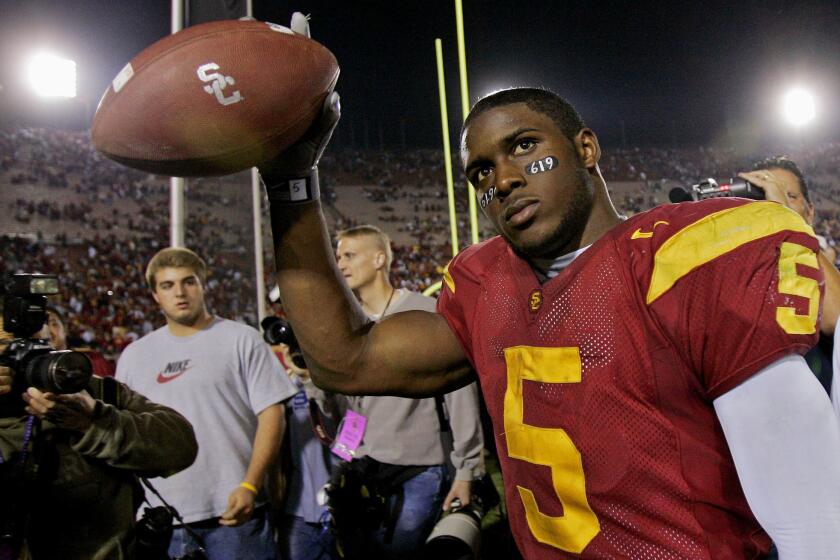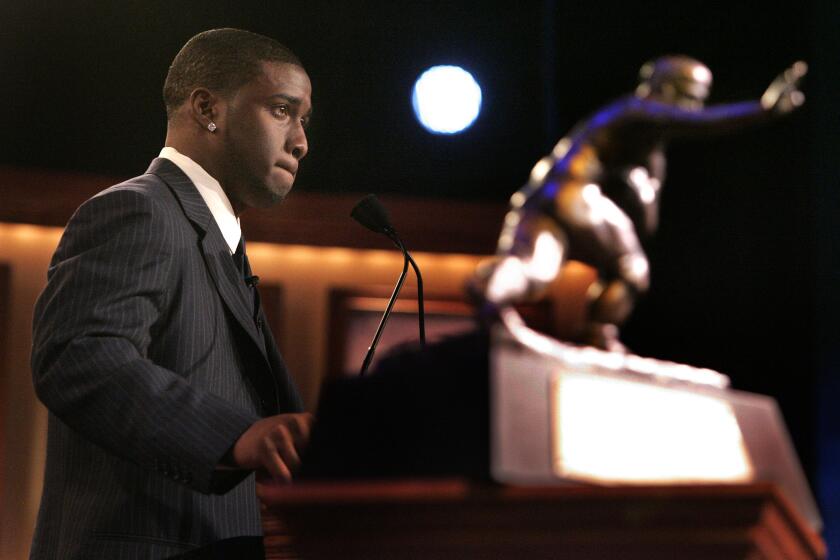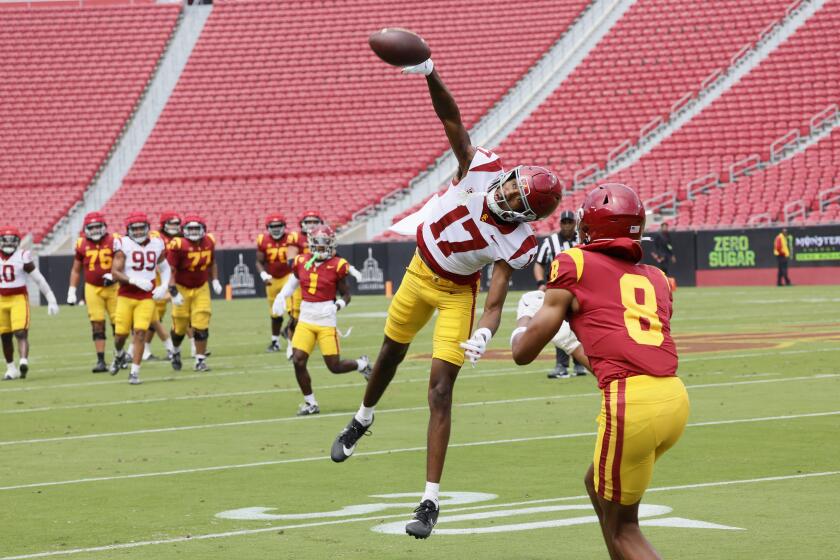Big Ten is out of place
The Rose Bowl introduced the Big Ten to the Pacific 10 at a cocktail party in 1947 and it was love at first sight.
It has been a wonderful relationship, except now, after all these years, the marriage is strained.
The shared experience is usually terrific right up until opening kickoff.
The battle of the bands, for instance, has always been competitive. There’s no way you can claim USC’s tuba player is better than Penn State’s.
As far as helmets go, Michigan’s winged headgear is head-and-shoulders above anything the Pac-10 has to offer.
It’s the football partnership that needs counseling.
Divorce is out of the question, because of the kids, but a separation might be in order.
The Rose Bowl is playing host to two games next year -- the traditional Jan. 1 game followed a week later by the Bowl Championship Series national-title game.
Keep your fingers crossed because there’s a chance the Big Ten won’t meet the Pac-10 in either game.
It’s sad to think the Big Ten can’t keep up anymore, but it can’t.
USC’s 38-24 win over Penn State on Thursday was just the latest flameout.
Some thought this year was going to be different. Few predicted anything as audacious as a Penn State win, but some predicted it could be close.
It was 31-7 at the half.
Penn State played better in the second half, and USC played worse, seeming to lose interest and a hard edge -- sort of what happened against Oregon State in September.
But it was what it was.
This Big Ten drought is probably cyclical and there’s a chance the landlocked league will someday return to Pasadena with a chance to win.
How about they phone ahead when that is about to happen?
USC is 24-9 in the Rose Bowl and 16-7 against the Big Ten.
USC hasn’t lost to the Big Ten in the Rose Bowl since the 1989 game against Michigan.
The last Big Ten team to win the Rose Bowl was Wisconsin over Stanford on Jan. 1, 2000.
Shoot, the best Rose Bowl the Big Ten has played this decade was against the Big 12, in 2005, when Michigan lost to Texas on a last-second field goal.
It wasn’t always this way.
After the Rose Bowl contractually partnered up with the conferences in 1947, the Big Ten won 12 of the first 13 meetings against the West Coasters.
It’s a wonder they didn’t cancel the series then.
Not even Joe Paterno, one of the greatest coaches in college football history, with a bowl record of 23-10-1 before the game, made a difference.
He watched the game from the press box and, for a time in the first half, it appeared USC might score his age (82).
Paterno’s team hit the Rose Bowl turf like junk falling out of the back of a pickup truck.
There were so many penalties called against Penn State before intermission, seven for 62 yards, you wondered if the yellow flags were made of Nittany linen.
“In the first half we just seemed to do dumb things we just did not do all year,” Paterno said.
There are educated guesses as to why the Big Ten can’t keep pace in big bowl games.
Too much time off between games is a legitimate concern. Big Ten schools finish the regular season before Thanksgiving.
Penn State ended this season with a win over Michigan State on Nov. 22, then sat around for more than a month.
USC closed its regular season with a win over UCLA on Dec. 6.
Paterno wouldn’t use the extra time off as an excuse, but did say: “I do think the Big Ten would do itself a favor if we could play a week or two after the season we have now.”
Paterno does think USC has a hometown advantage.
“Without, again, being a crybaby, I think, in all fairness, when you play Southern Cal, they’re home and they practice where they normally practice, and it’s a lot easier for them to get ready,” he said.
Speed is the other issue.
To prevail in the Big Ten, it has been said, teams have to be built to win November games in all kinds of weather.
It was Ohio State coach Woody Hayes who liked to say “three things can happen when you pass the ball and two of them are bad.”
Scheme and philosophy, though, really aren’t the issues anymore.
Many Big Ten schools now run spread offenses, including Ohio State and Penn State.
Yet, something is missing when these schools get into warm-weather bowl games against warm-weather schools.
USC quarterback Mark Sanchez had a career day, throwing for 413 yards and four touchdowns, by torching a veteran Penn State secondary that gave too much cushion to USC’s receivers.
Penn State’s defense did a good job stopping USC’s running game, holding the Trojans to 61 net yards.
So Sanchez just went elsewhere.
“They’re all seniors,” Sanchez said of Penn State’s defensive backs, “so they’ve seen a lot of football.”
But Sanchez knew his receivers -- Damian Williams, Ronald Johnson, Patrick Turner and Anthony McCoy -- had the speed advantage.
“We saw in the schemes speed on the outside, all-out team speed,” Sanchez said of his teammates, “and on offense we tried to exploit that and get the ball to the edge.”
The edge for Big Ten teams in bowl games these days usually leads to a cliff.
In the end, it was the same old Rose Bowl story -- too much USC and too much Pac-10. The conference, savaged this year for going 1-6 against the Mountain West in the regular season, finished with a 5-0 record in the bowls.
The Big Ten fell to 1-5, with Ohio State still left to play Texas in the Fiesta Bowl.
There really have been memorable Big Ten moments in the Rose Bowl, and if you’ll give me an hour I’ll try to recount some.
Oh yeah: In the 1998 game, Michigan won the AP national title with a victory over Washington State. And Wisconsin, led by Ron Dayne, bull-rushed UCLA and Stanford the next two years, but since then it’s the Big Zero.
You’d like to say better luck next year, but luck may have nothing to do with it.
--
Go beyond the scoreboard
Get the latest on L.A.'s teams in the daily Sports Report newsletter.
You may occasionally receive promotional content from the Los Angeles Times.




